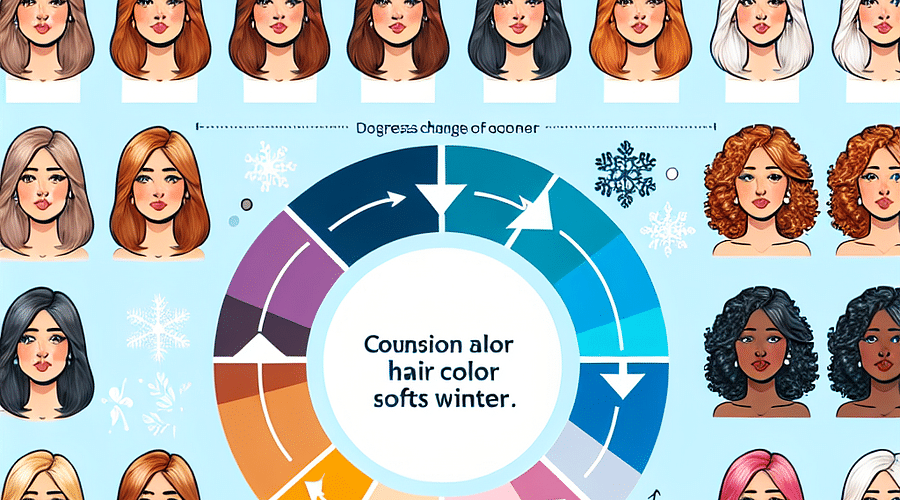Soft Summer to Soft Winter: Transitioning Your Hair Color with Seasonal Palettes

As the leaves turn and the air chills, our wardrobe isn't the only thing that undergoes a transformation. Hair color, too, can shift with the seasons to complement the evolving hues of nature and fashion. If you've reveled in the delicate tones of Soft Summer, you might find yourself yearning for a change as winter approaches. The transition from Soft Summer to Soft Winter isn't just about a wardrobe overhaul; it's about adapting your hair color to maintain harmony with your seasonal palette.
Before you consider a hair color change, it's essential to understand your seasonal color palette. Soft Summer individuals typically have cool undertones and look best in muted, dusty colors. As they move into Soft Winter, the palette deepens slightly while staying within the cool spectrum, embracing richer and slightly more vibrant hues. To determine if you're a true Soft Summer or on the cusp of Soft Winter, take this quick quiz.
Transitioning your hair color should be a subtle art form. It's not about drastic changes but rather about nuanced shifts that enhance your natural beauty. For those with lighter hair, think ashier tones or deeper blondes that suggest a wintry frostiness. Brunettes might consider rich mochas or cooler browns that mimic the earthy decay of late autumn leaves transitioning into winter's embrace.
Inspiration is everywhere when it comes to seasonal hair colors. From the silvery greys of a foggy winter morning to the deep blue-green of pine needles against snow, nature provides an endless palette to draw from. To visualize these inspirations and see how they translate into actual hair colors, browse through our curated image gallery.










The key is to find shades that resonate with both your personal style and the natural softness of your seasonal palette. For example, as we transition from Summer greens to Winter blues, consider how adding a touch of silver or cool brown can reflect these changes in your hair.
As we adjust our hair color for seasonal palettes, maintaining hair health is paramount. Cooler temperatures can lead to dryness and brittleness, so it's vital to invest in quality hair care products tailored for colored hair. Incorporate deep conditioning treatments into your routine and consider using leave-in conditioners or oils that provide extra moisture during colder months.
To further explore how different palettes can influence your style choices, dive into our comprehensive guide on mixing and matching Soft Summer and Soft Autumn palettes. And if you're still uncertain about which direction to take your winter hair color transformation, our "Is The Soft Winter Color Palette For You?" quiz will help clarify which shades will suit you best.
Wondering if you should transition your hair color to match the soft winter palette? This quiz will help you determine if the cooler tones of the soft winter palette are a match for you.
When considering dyeing your hair, it's important to take into account not just your skin tone but also your eye color and natural hair color. This ensures that the transition is harmonious and enhances your natural beauty. A professional colorist can help you navigate this change seamlessly.
As the seasons change, so does our style. If you're looking to transition your hair color to match the cool and subdued tones of Soft Winter, this quiz will help you determine which shade complements your complexion best.
Invest in quality sulfate-free shampoos and conditioners that are designed for color-treated hair. These products will help preserve your new hue and keep it looking vibrant throughout the season. Additionally, consider incorporating weekly deep-conditioning treatments to combat dryness.
Don't forget about regular trims! Keeping your ends neat not only gives off a polished look but also prevents split ends from traveling up the hair shaft and causing more damage.
For those who love hats, why not try berets or beanies in shades of navy blue or emerald green? They'll pair beautifully with Soft Winter locks while keeping you warm.





Incorporating scarves is another great way to accentuate your hair while adding an extra layer of warmth. Opt for patterns with cool undertones to maintain coherence with both your skin tone and seasonal wardrobe changes.
As you transition into these cooler months with a fresh look, remember that updating one's appearance isn't just about aesthetics—it's about how it makes you feel inside out. Whether you're exploring mixing and matching different seasonal palettes or diving headfirst into the Soft Winter palette, each choice is an opportunity for self-expression. Embrace these changes as part of an ongoing journey towards discovering what makes you feel most confident and true to yourself. After all, fashion is not just about following trends—it's about curating a personal style that reflects who you are. [community_poll: Vote on what type of content you want to see next regarding seasonal style transitions] Remember, transitioning between palettes doesn't have to mean an overhaul of everything in one go; it can be gradual—a few strands at a time—allowing you to savor each moment of transformation as we say goodbye to summer breezes and hello to winter whispers.
Post a comment